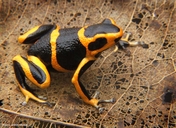|
Description
Ranitomeya summersi is a large species of Ranitomeya, with adults reaching 20.4 mm SVL. Adults have a black body with conspicuous orange ‘rings’ encircling the body and outlining the top of the head. An orange line is also present running along the dorsal surface of each limb. Ventral coloration is black with irregular orange lines. Little variation has been documented in this species, although the dorsal orange markings are sometimes broken or have branching patterns (Brown et al 2008). Distribution and Habitat
Country distribution from AmphibiaWeb's database: Peru
This species occurs in the central Huallaga Canyon near the towns of Sauce and Chazuta in San Martin, Peru. This species appears to be primarily associated with premontane habitats, occurring up to 684 m elevation. Habitats tend to be relatively dry, with reduced rainfall between the months of June through September. Life History, Abundance, Activity, and Special Behaviors
Ranitomeya summersi is a diurnal, terrestrial species. Little is known about the breeding behavior, although adults can frequently be found in Dieffenbachia axils which contain water. Courtship and egg deposition take place in leaf litter. Clutches consist of 4-9 eggs. Tadpoles are transported by the male to water bodies in tree holes or Dieffenbachia axils. These frogs can be found in disturbed areas, and can be locally abundant, especially in habitats with high densities of Dieffenbachia. Larva
A stage 29 tadpole has a total length of 19.0 mm and body length of 7.6 mm. Body ovoid in dorsal view. On the mouth, jaw sheaths are serrate and lack indentations. White, rounded marginal papillae are present around posterior labium and lateral parts of anterior labium. Labial tooth row formula 2(2)/3. In life, tadpole was gray without any distinct markings (Brown et al 2008). Trends and Threats
Much of this species’ potential habitat has been deforested, especially along Rio Huallaga and near the town of Sauce. This species has been smuggled for years, especially in the vicinity of Chazuta. Although R. summersi has not yet been officially evaluated as to population status, Brown et al. (2008) suggest this species be listed as Endangered (EN). Relation to Humans
Highly desired as a terrarium pet. Possible reasons for amphibian decline General habitat alteration and loss
Habitat modification from deforestation, or logging related activities
Comments
This species was long considered to be a morph of Ranitomeya fantastica (e.g. Silverstone 1975, Schulte 1999). Brown et al. (2008) provided morphological, genetic, and acoustic data which suggested this species was distinct enough to warrant full-species status.In 2011, the genus Dendrobates was subdivided into seven genera, including the new genus Ranitomeya by Brown et al (2011).
References
Brown J.L., Twomey E., Amézquita A., De Souza M.B., Caldwell J.P., Lötters S., Von May R., Melo-Sampaio P.R., Mejía-Vargas D., Perez-Peña P., Pepper M., Poelman E.H., Sanchez-Rodriguez M., and Summers K. (2011). "A taxonomic revision of the Neotropical poison frog genus Ranitomeya (Amphibia: Dendrobatidae)." Zootaxa, 3083, 1-120. [link]
Brown, J. L., Twomey, E., Pepper, M., and Sanchez Rodriguez, M. (2008). ''A revision of the Ranitomeya fantastica species complex and two new species of poison frogs (Anura: Dendrobatidae) from the Rio Huallaga drainage in central Peru.'' Zootaxa, 1832, 1-24.
Schulte, R. (1999). Pfeilgiftfrösche. Artenteil - Peru. Inibico, Waiblingen.
Silverstone, P. A. (1975). ''A revision of the poison-arrow frogs of the genus Dendrobates Wagler.'' Natural History Museum of Los Angeles County, Scientific Bulletin, 21, 1-55.
Originally submitted by: Evan Twomey (first posted 2009-05-25)
Edited by: Kellie Whittaker, Brent Nguyen (2023-02-12)Species Account Citation: AmphibiaWeb 2023 Ranitomeya summersi <https://amphibiaweb.org/species/7168> University of California, Berkeley, CA, USA. Accessed Jan 7, 2025.
Feedback or comments about this page.
Citation: AmphibiaWeb. 2025. <https://amphibiaweb.org> University of California, Berkeley, CA, USA. Accessed 7 Jan 2025.
AmphibiaWeb's policy on data use.
|




 Map of Life
Map of Life